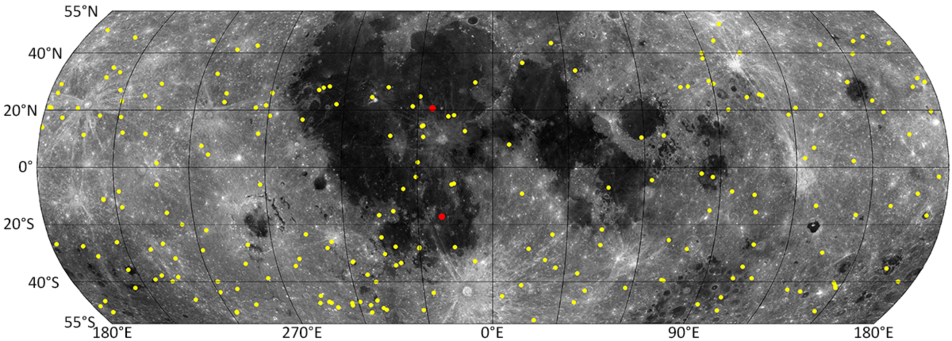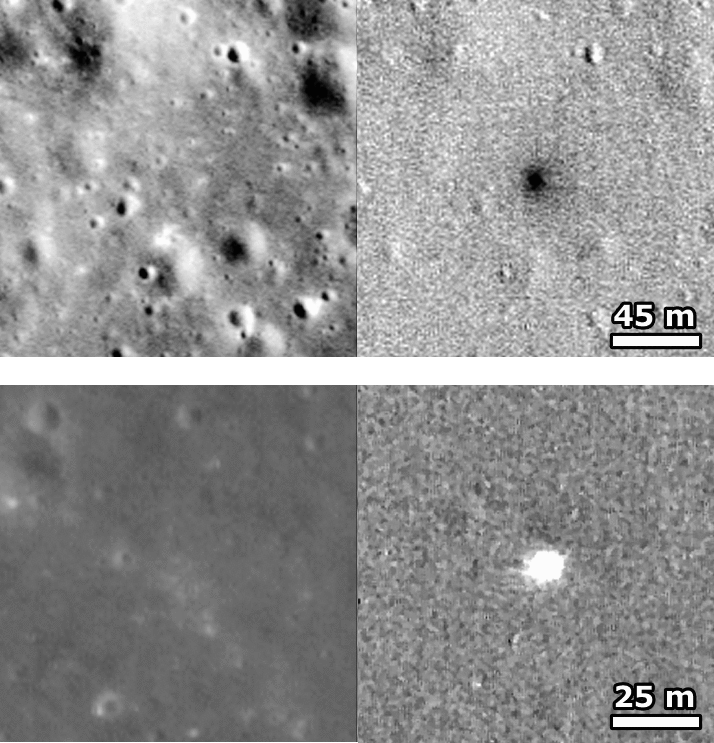
Before the launch of the Lunar Reconnaissance Orbiter (LRO), it was thought that the Moon’s surface did not change much on a human timescale, and that erosional processes took hundreds of thousands or even hundreds of millions of years to significantly alter the surface. Now, the LROC Narrow Angle Camera (NAC) meter-scale images are revealing small surface changes that are transforming the surface much faster than previously thought! From before and after images (temporal pairs) acquired by the NAC, we identified over 200 impact craters that formed during the LRO mission. These new craters range from several meters up to 43 meters in diameter.

By analyzing the number of new craters and their size, and the time between each temporal pair, we estimated the contemporary cratering rate on the Moon. Knowing the number of craters that form each year is important when estimating absolute ages of the youngest regions. During our search, we identified more new craters than anticipated by previous cratering models. With this potentially higher impact flux, geologic units with young model ages derived using crater counts and the current rate may in fact be even a bit younger than previously thought. However, to be certain, we need several more years of observations and new crater discoveries.
Similar to the 17 March new crater, we also found that these new impact craters are surrounded by complex reflectance patterns related to material ejected during crater formation. Many of the larger impact craters (>10 meter diameter) exhibit up to four distinct bright or dark reflectance zones. These zones are most visible with ratio images from the temporal observations (dividing the after image by the before image). Nearest to the impact site, there is usually both a zone of high reflectance and a zone of low reflectance. These two zones were likely formed as a layer of material that was ejected from the crater during the impact, and extended outward about five crater radii from the rim.
Past the reflectance zones near the crater (known as proximal zones) are one or two reflectance zones (also high reflectance and low reflectance, they are called called distal zones). While these distal reflectance patterns are nearly impossible to distinguish in the after image alone, the temporal ratio image clearly brings out their extent and shape. From analyzing multiple impact sites, we see that in some cases the far flung ejecta patterns wrap around small topographic obstacles, indicating that the material was traveling along a trajectory nearly parallel with the ground. This kind of path is only possible if the material was ejected at very high velocities from the early jetting phase of an impact. Jetting occurs just as the impactor contacts the surface at hyper-velocity speeds (on average 16 km per second; 10 miles per second, or 36,000 miles per hour!). The jet contains vaporized and molten rock, which moves rapidly (sometimes faster than the original impactor) over the surface, disturbing the upper layer of lunar regolith (soil), and modifying its reflectance properties. The outer high reflectance zone formed from this jetting might be in some ways analogous to the bright region that forms around a landing site when the exhaust from a descending spacecraft modifies the surface reflectance during descent.

In addition to discovering impact craters and their fascinating ejecta patterns, we also observed a surprising number of small surface changes, which we call splotches. While these splotches lack resolvable rims, they are most likely caused by small impacts. We see dense clusters of these splotches around new impact sites suggesting that many splotches may be secondary surface changes caused by material thrown out from a nearby primary impact event. From 14,000 NAC temporal pairs, we have identified over 47,000 splotches so far. We estimated their accumulation over time, and from measuring their size we inferred how deeply each splotch dug up the surface. From this depth estimate and the frequency of formation we calculated how long it takes to effectively churn, or garden, the upper few centimeters of regolith. This relentless churning will turn over 99% of the surface after about 81,000 years; a rate significantly faster (>100x) than previous models that considered overturn from micrometeoroid impacts alone, and ignored the effects of small secondary impacts (splotches). This revision to the gardening rate is important when analyzing remotely sensed observations (for example data from cameras and X-ray and Gamma-ray spectrometers), which probe this upper regolith layer. Furthermore the churning rate will be important information for future designers of Moon bases – surface assets will have to be designed to withstand up to 500 meter per second impacts of small particles. On a lighter note, the increased rate means that the astronaut and rover tracks will be gone in a few tens-of-thousands of years, rather than a few million.

Throughout the new two-year extended mission (Cornerstone Mission, 1 October 2016 through 30 September 2018) just approved by NASA, and future LRO extended missions, LROC will continue to acquire these valuable temporal observations. As the mission continues, the odds increase of finding larger impacts that occur more infrequently on the Moon. Such discoveries will enable us to further refine the impact rate and investigate details of impact cratering, the most important process that shapes planetary bodies across the Solar System.
Colorized topography derived from NAC stereo observations overlaid on an orthographic mosaic centered on a new 43 m diameter crater (14.39°N; 331.73° E). The topographic data is used to investigate how the local topography affects ejecta emplacement, and in turn how ejecta travels across the surface (topography and orthophoto derived from M1175595764LR and M1175609975LR) [NASA/GSFC/Arizona State University].
Read the full article in Nature.
Related Featured Images
New Impact Crater on the Moon!
Published by Mark Robinson on 12 October 2016